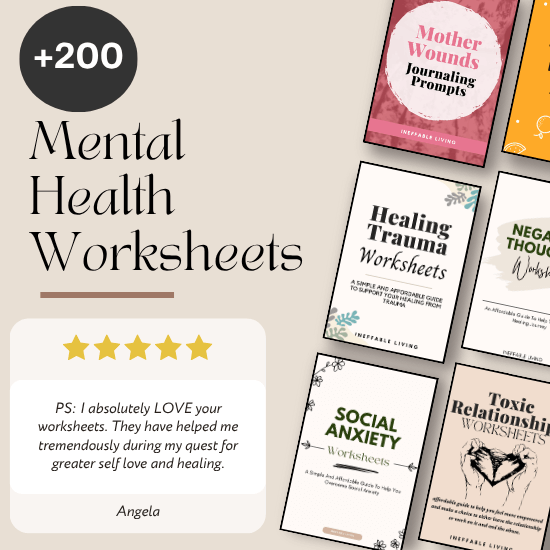Mental health worksheets can be powerful tools for healing, but only when used with intention and care. Sometimes, the way we approach them can actually limit their impact—or make us feel stuck, frustrated, or disconnected. If worksheets haven’t helped you the way you hoped, you might be making one of these common mistakes. The good news? Every mistake has a simple fix.
The Hidden Pressure to “Heal Fast” Through Worksheets
Mental health worksheets are powerful tools for growth — but they can also come with an unspoken pressure: the need to heal fast. When you’re struggling, it’s easy to look at a worksheet and think, If I just fill this out, I’ll feel better right away. But healing doesn’t follow checkboxes or page counts. The process takes time, and worksheets are meant to guide that process — not rush it.
Many people unknowingly treat worksheets like a race. They push through pages quickly, hoping for instant relief or breakthrough moments. But when used this way, worksheets can become another form of self-pressure — a subtle message that you’re only doing well if you’re “finishing” your healing. This can lead to frustration, disappointment, and even shame when progress feels slow or non-linear.
True healing through worksheets comes not from speed, but from presence. It’s about slowing down, sitting with what’s uncomfortable, and allowing space for reflection without judgment. Worksheets are not quick fixes — they’re invitations to pause, to explore, and to care for yourself one page, one thought, one emotion at a time. Let go of the pressure to heal fast. Real change happens in the moments when you give yourself permission to go slow.
Related: Stuck in Heartbreak? These Worksheets Can Help You Let Go and Begin Again
The 6 Most Common Mistakes People Make with Mental Health Worksheets
1. Treating Them Like Homework
Filling out worksheets just to “get them done” misses the point. Healing isn’t about perfect answers—it’s about honest ones. Rushing through or checking boxes keeps you on the surface instead of going deeper.
2. Avoiding the Hard Questions
It’s natural to skip over questions that feel too emotional or confusing. But those are often the ones that hold the most healing. Skipping them can reinforce avoidance patterns that keep you stuck.
3. Looking for “Right” Answers
There are no correct responses in mental health work. Trying to write what you should feel or ought to think disconnects you from your real experience—and makes healing feel like a performance instead of a process.
4. Not Reflecting After You Fill Them Out
Filling out a worksheet is only part of the process. If you don’t take time to reflect on what you wrote, the insight can fade. Pause afterward and ask: What did I learn? What do I want to do with this?
Related: Struggling with Body Image? These Worksheets Support Healing and Self-Acceptance
5. Doing It Alone When It’s Too Much
Some worksheets can bring up deep pain or overwhelming emotions. If you’re struggling with trauma, grief, or intense feelings, it’s okay to pause and bring the worksheet into therapy—or reach out for support.
6. Being Inconsistent
Doing one worksheet and expecting major transformation sets you up for disappointment. Real change comes from consistency. Use worksheets as a practice, not a one-time event.
Related: Always Anxious? These Worksheets Can Help You Calm Down Fast
How Misusing Worksheets Can Reinforce Avoidance
While mental health worksheets are powerful tools for self-reflection and healing, how you use them matters. When misused, they can unintentionally become a way to avoid real emotional work instead of supporting it. Here’s how that happens:
- Overfilling pages without feeling – Writing long answers without actually connecting to the emotion underneath can turn the process into a performance rather than reflection. You might look productive, but you’re not processing anything deeply.
- Using worksheets to avoid hard conversations – Instead of bringing your thoughts into therapy or sharing openly with someone safe, you might hide behind the worksheet, avoiding the discomfort of vulnerability.
- Jumping from one worksheet to another without finishing – Constantly starting new worksheets without completing or sitting with the content can keep you in a cycle of surface-level reflection without lasting insight.
- Focusing only on intellectual analysis – Some people use worksheets to think about their emotions without actually feeling them. This can reinforce emotional detachment and block healing.
- Treating worksheets like a checklist – When worksheets become just another task to complete or perfect, they lose their therapeutic value. The goal isn’t to finish them — it’s to use them to connect with yourself.
Worksheets are meant to support healing, not replace it. If you notice yourself using them to stay emotionally safe or avoid discomfort, it’s a sign to slow down and bring compassion into the process. Sometimes the most helpful thing is not doing more — it’s pausing and asking, “What am I really avoiding right now?”
Related: Recovering from Abuse? These Worksheets Will Help You Reclaim Your Power

Conclusion
Worksheets can guide, support, and deepen your healing—but only when you use them with patience, honesty, and self-compassion. Avoiding these common mistakes can turn a frustrating tool into a life-changing one. The worksheet isn’t where the healing ends—it’s where it begins.